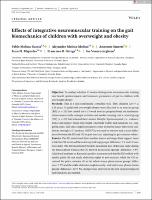Por favor, use este identificador para citar o enlazar este ítem:
https://repositorio.usj.es/handle/123456789/956
| Título : | Effects of integrative neuromuscular training on the gait biomechanics of children with overweight and obesity |
| Autor: | Molina-Garcia, Pablo


Molina-Molina, Alejandro 


Smeets, Annemie 


Migueles, Jairo H. 


Ortega, Francisco B. 


Vanrenterghem, Jos 

|
| Palabras clave : | Exercise therapy; Flatfoot; Gait analysis; Musculoskeletal pain; Pediatric obesity |
| Fecha de publicación: | 2022 |
| Editorial : | Wiley |
| Citación : | Molina-Garcia, P., Molina-Molina, A., Smeets, A., Migueles, J. H., Ortega, F.B., Vanrenterghem, j. Effects of integrative neuromuscular training on the gait biomechanics of children with overweight and obesity. Scand J Med Sci Sports. 2022;32:1119–1130. https://doi.org/10.1111/sms.14163 |
| Resumen : | Objective: To analyze whether 13 weeks of integrative neuromuscular training can benefit spatiotemporal and kinematic parameters of gait in children with overweight/obesity. Methods: This is a non-randomized controlled trial. Fifty children (10.77 ±1.24 years, 31 girls) with overweight/obesity were allocated to an exercise group (EG) (n = 25) that carried out a 13-week exercise program based on fundamental movement skills, strength activities and aerobic training, and a control group (CG) (n = 25) that followed their normal lifestyle. Spatiotemporal (i.e., cadence, stance and support times, step length, and stride width) and kinematic (i.e., hip, pelvis, knee, and ankle angles) parameters were evaluated under laboratory conditions through a 3D analysis. ANCOVA was used to test raw and z-score differences between the EG and CG at post-exercise, adjusting for pre-exercise values. Results: The EG maintained their baseline stance and single-limb support times while the CG increased them during walking (groups’ difference: 3.1 and 1.9 centiseconds). The EG maintained baseline maximum foot abduction angle during the stance phase whereas the CG showed an increase (groups’ difference: 3.9º). Additional analyses on kinematic profiles demonstrated that the EG walked with similar pelvic tilt and ankle abduction angles at post-exercise, while the CG increased the pelvic anterior tilt in the whole stance phase (mean groups’ difference: 7.7º) and the ankle abduction angles in early-and mid-stance phases (mean groups’ difference: 4.6º). No changes were observed in the rest of spatiotemporal and kinematic parameters. Conclusions: The integrative neuromuscular training stopped the progression of some biomechanical alterations during walking in children with overweight/obesity. These findings could contribute to preventing common movement-derived musculoskeletal disorders in this population, as well as preserving an optimal mechanical efficiency during walking. |
| URI : | https://repositorio.usj.es/handle/123456789/956 |
| ISSN : | 1600-0838 |
| Aparece en las colecciones: | Artículos de revistas |
Ficheros en este ítem:
| Fichero | Descripción | Tamaño | Formato | |
|---|---|---|---|---|
| Effects of integrative neuromuscular training on the gait biomechanics of children with overweight and obesity.pdf | 623,39 kB | Adobe PDF |  Visualizar/Abrir |
Este ítem está sujeto a una licencia Creative Commons Licencia Creative Commons

